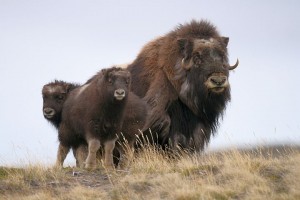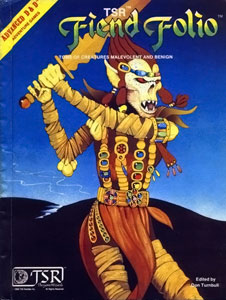It is no secret that the classic character races in Dungeons & Dragons, consisting of human, elf, dwarf, and halfling, are taken from The Lord of the Rings, as well as the standard enemies of orcs and goblins. However, a huge number of other creatures from the many Monster Manuals are neither original creations, nor taken from various mythologies as well. A great number of monsters and critters has been lifted directly from literature, a method that was at least continued until 2000 with the first Monster Manual for the 3rd Edition. Which is a completely legitimate thing to do, and there are countless of appearances in videogames of creatures that are very clearly beholders, which are one of the most famous original creations of D&D.
However, as I’ve been reading some older fantasy stories this year, I had a number of “Hey, I know that thing!” moments, and I think it would be interesting to share those.
- The “Prehistoric Animals” Toys: These are probably the best known group by now. I don’t know who exactly is responsible for their creation, but the rust monster, bullete, and owlbear are all based on cheap plastic toy monsters from Hong Kong. Toni DiTerlizzi wrote a very good article about them last year. The carrion crawler is also based on a similar plastic monster from a different source.
- Grimlocks: I was actually quite surprised to learn that apparently grimlocks appear only in very few cases outside of D&D. I had been kind of asuming that they were based on some local legend somewhere in Europe, but apparently they are simply a slightly altered version of the morlocks from the 1895 novel “The Time Machine” by H.G. Wells.
- Thri-kreen: These are one of the iconic creatures of the Dark Sun setting, but actually they are based very closely on the tharks from the novel “A Princess of Mars” by Edgar Burroughs, which was released in 1917. They are tall, green, have two legs and four arms, a pair of big tusks, big eyes, can jump very high and far, and are a nomadic people of the desert. The only major change in Dark Sun was to make them insectoid, while the tharks of Mars seem to be more reptilian, if anything.
- Girallon: These monsters first appeared in the Monster Manual for the 3rd Edition and are both relative newcomers and not particularly popular in D&D. However, they are also taken stright from “A Princess of Mars” as well, where they are simply called White Apes. Giant gorillas with white fur and four arms. There is really no room for ambiguity there.
- Purple Worm: Giant subterranean worms like these appear in H.P. Lovecrafts story “The Dream Quest of Unknown Kadath” from 1929, where they are called dholes. A similar concept appears in the sand worms of Frank Herberts 1965 novel “Dune”.
- Yuan-ti: The resamblance of Yuan-ti to the naga of Southeast-Asia is easy to see, but the specific details of these creatures are very close matches to the Serpent Men, who appear in several stories by Robert Howard. They first seem to have appeared in the 1929 story “The Shadow Kingdom”, where they are a race of humanoids with snake heads, who have the ability to disguise themselves as humans and many magical powers, and worship the gods Set and the Great Serpent. The 1932 story “Worms of the Earth” also has what would be a yuan-ti pureblood.
- Elder Brain: The Elder Brains of the ilithids, though not the ilithids themselves, appear first in the 1930 novel “Last and First Men” by Olaf Stapledon. In the book, they are the Fourth Men and control the Fifth Men, which are very much unlike mind flayers.
- Kuo-toa: While many of the specific abilites of the kuo-toa are unique to the creature from D&D, these creatures are very closely based on the Deep Ones, that first appeared in the story “The Shadow over Innsmouth”, which was written by H.P. Lovecraft in 1931.
- Gibbering Mouther: The creature that appears in D&D as the gibbering mouther is a severely downgraded version of the Shoggoth, another famous monster from Lovecrafts stories, which had its first appearance in “At the Mountains of Madness” from 1931.
- Grell: A creature looking pretty much identical to a grell except for the color appears on one edition of the “Legion of Space” by Jack Williamson, which was written in 1934. In the story, the creatures are called medusae.
- Worg: The creature, as it appears in D&D, is basically identical to the wargs from Tolkiens “The Hobbit”, which was published in 1937.
- Displacer Beast: These creatures are based on the ceurl from the 1950 sci-fi novel “The Voyage of the Space Beagle”. They also appear in many Final Fantasy games under their original name.
- Xill: The xill is a rather obscure monster in D&D, even though they have been around since the original Fiend Folio and reappeared both in Planescape and the 3rd edition Monster Manual. Like the displacer beast, they are taken from “The Voyage of the Space Beagle”, where their name is ixtl.
- Frost Worm: The frost worm first appeared under the name remora in the 1969 story “The Lair of the Ice Worm” by L. Sprague de Camp and Lin Carter. It’s practically identical in every aspect.
- Spider Eater: This monster is strongly based on the sith from the Barsoom novel “The Warlord of Mars”.
- Lich: The classic undead wizard is not an original creation by any specific author, but is indeed a figure from slavic legend. Koshei the Deathless is a powerful sorcerer so ancient that his body has decayed to almost nothing but a starved skeleton, and who has gained immortality by hiding away his soul in a magical box which is safely secured in a secret place.


